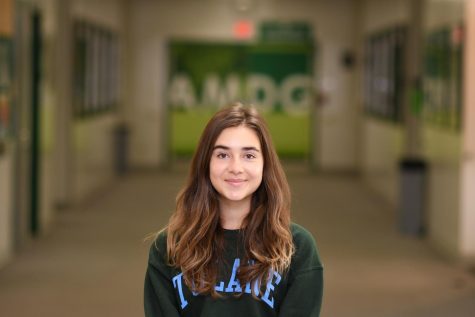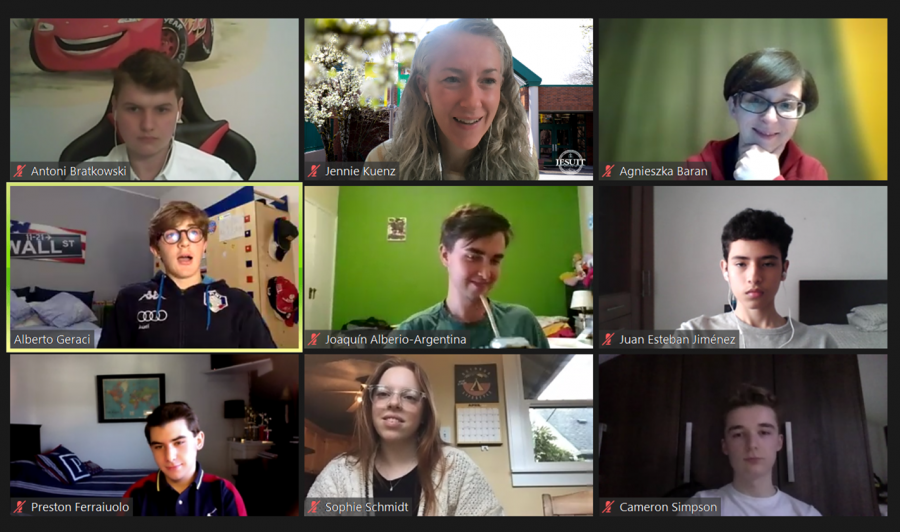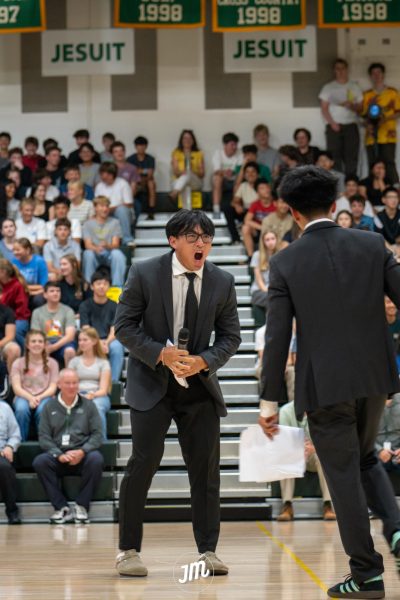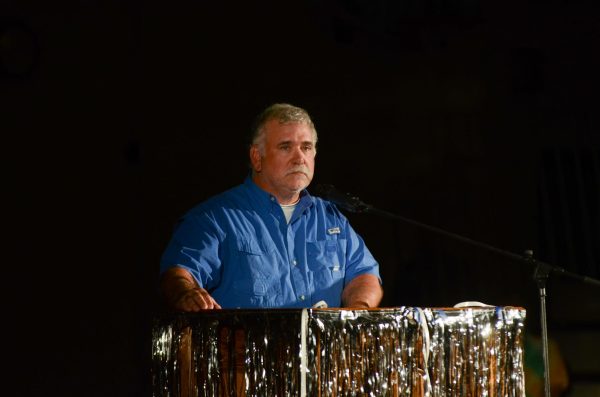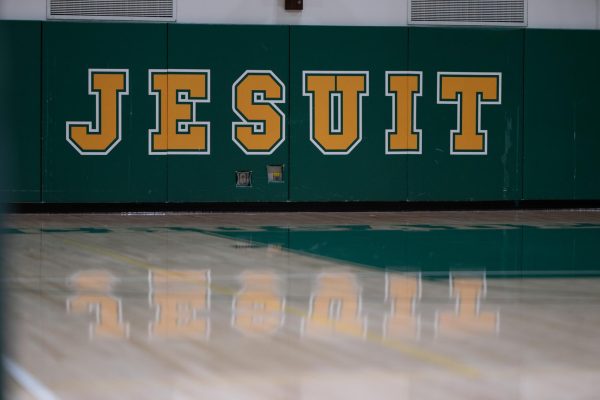Jesuit Global Activism Leadership Summit
Over three consecutive Saturdays in March, four students from Jesuit High School of Portland, OR participated in the inaugural Jesuit Global Activism Leadership Summit over Zoom.
Led by Robert Chura, Director of Global Education at St. Louis University High School, and facilitated by his colleague Marias Pas Campos, the Assistant Director of Global Education at St. Louis, the purpose of the summit was to discuss and come up with solutions to three of the United Nations Sustainable Development goals (SDG): Clean and Affordable Energy, Gender Equality, and Zero Hunger.
The ultimate goal of the summit was to advance “global competence” among the students and teachers under the guidance of Ignatian principles. The following experiential learning goals based off of the summit’s flyer are listed below.
- Show the way to God through discernment and the Spiritual Exercises
- Allow participants to walk with the excluded
- Cultivate a deep sense of care for our common home
- Create opportunities for participants to journey with the world’s youth and peers
According to Chura, 18 Jesuit High Schools participated in the summit worldwide, which involved 84 students and 40 teachers. The summit was open to both male and female ages 14-18. To keep the summit controlled and manageable for its first occurrence, teachers from every school picked four to five exemplary students. Those students from Jesuit High School were senior Abigail Rawlinson, junior Sophie Schmidt, junior Elizabeth VanDomelen, and myself.
Each of the participating Jesuit students expressed similar reasons for why they decided to participate in the summit; it was an opportunity to interact and collaborate with students from around the world on a subject of personal interest.
“I chose to participate because for most of my life, I feel like I’ve lived inside my comfort zone, so I wanted to do something that gave me a chance to build my leadership skills and connections to other teenagers who care about the same things I do,” Vandomelen said.
“It had everything that I was looking for before tennis season started,” Rawlinson said. “It was a way for me to connect with people from Jesuit and from around the world. We were talking about issues that were important to me, I was able to write and research and learn, and I am always interested in doing that.”
“I thought it would be a really unique opportunity, and I’m interested in other cultures,” Schmidt said. “I was supposed to go on a French exchange program last summer, but obviously that got cancelled, so I thought it would be really good to meet people from other countries… [and] be able to work towards a solution for the sustainable development goals.”
I personally signed up for this summit because I thought it would be an amazing opportunity to connect and collaborate with students from around the world in a meaningful way since we could work together to come up with action plans against worldwide social injustices.
Before the summit began, students signed up for a sustainable development goal of their interest. The three United Nations sustainable development goals that students could choose from were Clean and Affordable Energy, Gender Equality, and Zero hunger. Based on their choice, students were placed into a group with the same sustainable development goal and were tasked with the responsibility of coming up with a possible solution to their social, economical, or political issue.
“With the SDG’s we chose, we tried to be mindful about doing something that was environmental [such as Clean and Affordable energy], interpersonal [like Gender Equality], and global, like Zero Hunger,” Chura said. “We picked three that we felt covered a variety of possible interests and ways to look at global issues, but all 17 of them are awesome.”
Students had three options to choose from for their group’s project: creating an action plan, recommendations to elected leaders, funding for the future. On the last day of the summit, Saturday, March 27, each group demonstrated their learning and comprehension of their sustainable development goal by presenting their project to other sustainable development groups.
Chura believes that the three options “spoke to a variety of talents” and honored the varying approaches individuals may take when collaborating with diverse groups. Furthermore, he emphasized how impressed he was with everyone’s presentations.
“I was in charge of SDG 2 (Zero Hunger),” Chura said. “I watched all three SDG’s and every single one was amazing. The high-quality of work and reflection and insight…I was really impressed by that.”
Jennifer Kuenz, Associate Director of Ecological Justice & Global Networking, Physics Teacher at Jesuit High School, was a part of the planning committee for the summit and expressed similar sentiments about the presentations.
“More than anything, our time together was enriching; it was enlightening,” Kuenz said. “I was amazed how of course everyone spoke English very well…and how willing people were to speak candidly about what is going on in their schools and their challenges, but such a collaborative mindset and sharing of ideas.”
After speaking with the other Jesuit students involved in the summit, it was interesting to learn that many of their groups decided on different media with which to present their projects, and was based on their partners’ familiarity with the technology or their approaches to working.
My group made a PowerPoint to present our project,” Vandomelen said. “We all described how hunger affects our individual countries and what we do locally to help eliminate hunger. I felt like our presentation went very well. We presented confidently, we were well prepared, and we paced ourselves well.”
“We used Google Slides because everyone could work on it at the same time, and we were working on it throughout the week and that day,” Rawlinson said. “It was interesting because everyone had very distinct and different approaches to how we formatted our slides and how we went about sharing our information. Everyone really knew how to use the technology, which just really shows how pervasive Apple and Google have become.”
Each Summit participant faced some challenges throughout their experience, with the most common challenges being communication and technology.
“The most challenging part was the technological side,” Chura said. “We knew that there was no way we were going to be absolutely perfect and flawless on this. As powerful as these virtual experiences are, there are some potential pitfalls. We spent probably the entire last month working through all the potential what-ifs. At times we had to go to plan B, and we were grateful that we had that advanced planning.”
“We just had to compromise,” Schmidt said. “Throughout this whole summit, in our group we just had to be okay with not doing exactly what we wanted to do, and in the end I think everyone enjoyed it.”
“For me, I struggled with reading the body language of the fellow people in my group,” Rawlinson said. “When we do school here [at Jesuit] I know how people look when they are confused or look when they are happy because I have seen them in-person, but I can’t pick up on those subtle cues online with these people I have never met before. There were sometimes when we were debating the logistics of the project, I wasn’t really sure if everyone was really on-board or if everyone was going along with it for the sake of group.”
“Communication was a struggle in our group, especially when someone spoke and no one understood, so we all just sat in silence trying to process it,” Vandomelen said. “We eventually sorted out the issues and communicated better.
When asked the previous question, Ms. Kuenz spoke about what she learned about the challenges of her collaborator from Zimbabwe.
“In Zimbabwe they have rolling blackouts because of power issues and lack of infrastructure for energy, and so the people who have the means, have solar panels, and the people who don’t, don’t,” Kuenz said. “If schools are closed and when you talk about remote learning, you have to figure out another way to do that.”
One the first day of the summit, students used Google Jam Board to draw and write about things that symbolized their country. This activity is where most students learned about the backgrounds of their peers. According to the participants, learning about the cultural backgrounds of their group members was an informative and enriching experience.
“I think one of the funniest things that happened was on the first day, one of my fellow group members was from India said, ‘Everyone, you need to check out this singer, his name is Justin Timberlake, he’s awesome,’ and I just thought that despite our differences we consume the same media and we have very distinct cultures but there is a part of culture like art or music that transcends boundaries,” Rawlinson said.
“I learned something funny about one of my group members,” Vandomelen said. “She thought that high school in the US is exactly like school in popular American films she has seen. For some of the other members, I learned how much emphasis their daily life puts on God and pride for their country.”
When asked about their biggest takeaway from the summit, most interviewees spoke about the value of collaboration and learning about the United Nations sustainable development goals at a young age.
“One of my most important takeaways from the summit was although we live so far apart, connection in my group was so simple once we realized the similarities that connect us and the differences that become fun topics of discussion in a low-pressure environment,” Vandomelen said.
“I was inspired by the research and the thoughtfulness that my group shared and did during our SDG presentation,” Rawlinson said. “From it, I learned that gender inequality starts at a small level and [talking about it at] Jesuit is pretty easy because there are already the foundations of treating everybody with respect. It’s part of what the Catholic faith is about, and it is a part of what this school is about, so if I just continue to live that mission at Jesuit I am fulfilling what my group wanted with the SDG.”
“I definitely think it was a really great introduction to the SDG’s because I hadn’t really heard about them before, and we only really talked about three,” Schmidt said. “In the future, I want to learn more about the other ones.”
Both Chura and Kuenz voiced how impactful the summit was for them as teachers and for the students as they oversaw their collaboration.
“I didn’t know that the [summit] would be as big of a deal as it was,” Chura said. “When you have that common Jesuit background…and are able to discern, I thought it was amazing to see how quickly you all became fast-friends and built partnerships and collaborations. There was active, really involved, careful, intentional work going on. As an educator, that is why you do your job.”
“Our shared mission drives us in a similar way,” Kuenz said. “The first day I got goosebumps just listening to the teachers introduce themselves and where they were from. It was so cool. There are schools all over the world that care about the same thing: to empower all of you to realize that you can make a difference.”
